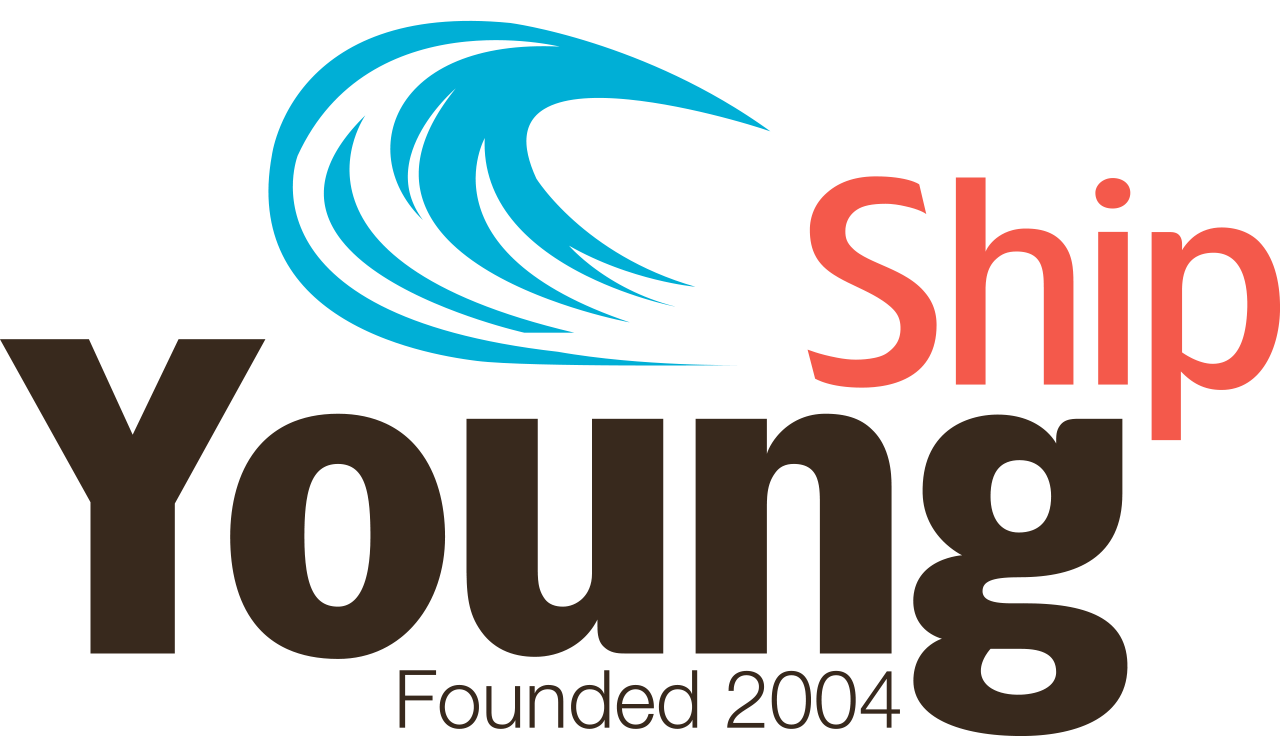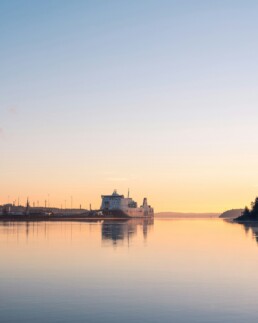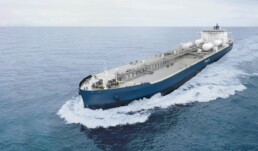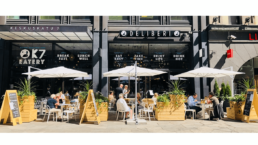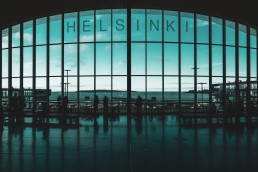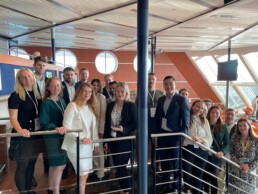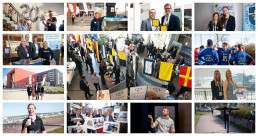17.6 Discover the legacy of Shipbroking in Finland together with OOCL
Navigation and trade have always been interconnected. During the age of sailing ships, the shipowner also served as the shipmaster, managing cargo, navigation, and trade at ports. The introduction of steam power in the 1800s revolutionized this process, leading to the establishment of agents who handled port routines and trading tasks, evolving into today's shipbrokers.
Shipbrokers in Finland
In Finland, organized shipbroking activities began in the 1700s. By 1720, all towns were required to have official shipbrokers to handle contracts and receive brokerage fees. In 1748, it was mandated that only licensed shipbrokers could practice clearance, with licenses granted by the magistrate. The Finnish Shipbrokers Association, founded in 1920, has been a cornerstone of the industry.
Join Youngship Helsinki on June 17th at 17.00 for a visit to Shipbrokers Finland (Köydenpunojankatu 8) together with OOCL.
The agenda includes:
- A presentation by OOCL
- A presentation by Shipbrokers Finland
- After-work socializing
Due to limited space, only 12 people can join. Don’t miss this opportunity to explore the history and practice of shipbroking in Finland.
Register for our visit to the Finnish Ship Brokers together with OOCL.
The low carbon story – part one
What are my options?
We have recently been working with several development projects, but also with many actual commercial projects, which are aiming for zero or very low carbon operation in future years. I recently said in an article in Motorship, “it's exciting to be an engineer today”. Indeed, all those years working for energy saving and emission reductions in a small team and finding ways to include the necessary analysis in our commercial products because it’s the right thing to do… well, now all those analysis methods are being put to work in all our projects. And those technologies that could not make it to projects due to demand for pay-back time in 2-3 years suddenly become feasible if we expect that the cost of carbon-neutral or low-carbon shipping will be high, as we calculated with DNV and partners in our latest joint industry project.

Figure: Example result from the JIP with DNV, Deltamarin, Total and Minerva Marine: Total cost of ownership for a medium-range (MR) tanker with different fuel and technology options.
So yes, it’s great to be an engineer today! I was thinking of fast-tracking some ideas and things that I have learned during the past 1-2 years in the field of low-carbon shipping. So, read this if you are interested in reducing the carbon footprint of ships! This blog series is also be a small part of a new upcoming Elsevier book Sustainable Energy Systems on Ships, which will provide holistic views on modern energy-efficient technologies and design methods in shipping.
Zero-carbon or carbon-neutral?
When aiming for an extremely environmentally efficient ship, the options are numerous and there are many choices to be made regarding the ship’s main engines and fuel. The first step in the process, as in regular energy efficiency projects, is to define the goal for the project. The goal might be to follow the generic vision of the IMO or global trends to reach carbon neutrality or a certain level of carbon intensity. This goal can be set for a single ship or an entire fleet transport assignment. It is also important to separate single vessel development from total fleet development.
The figure below shows a conceptual example of a total fleet carbon intensity assessment, which is always based on the actual performance data of ships, including existing vessels, and projection to new fleet development. The figure also illustrates the main reasons for improved carbon performance in the example case with a new fleet slowly replacing the older one. Our example case analysis also reveals a trend that is evident in the IMO studies and in our other development projects: it is possible to reach 30-40% reductions in ship carbon intensity with fossil-based fuels thanks to energy saving in operation and good design. Regarding fuel choices that are relatively common today, LNG as a fuel has a lower carbon footprint than diesel. LNG alone could be a future-proof and carbon-neutral fuel if it is based on bio-stock or produced synthetically with captured carbon and green electricity. The same naturally goes for any other fuel, so it is likely that in the future more attention will be paid to the total well-to-wake assessment of a ship’s fuel environmental footprint, so we as a design company have started to prepare such an analysis in our projects.
In the news, I’ve recently seen now many shipping companies setting out their vision and ambition for future environmental performance, and in some cases concrete projects have been published afterwards. This kind of continuous strategic goal setting and evaluation process is important for actual decarbonisation work, since the applied technologies and fuels will surely change in the future, when more regulations, infrastructure and knowledge are available.

Figure: Summary of the main reasons for the development in fleet carbon intensity for an example fleet including both existing vessels and a prediction of introducing new ships to the fleet.
Technical steps to take
With or without a larger total fleet assessment, major improvements in carbon intensity are always realised as projects, retrofits or newbuilds. No matter how well specified the methods for decarbonisation are for technologies or fuel choices, there is usually one common denominator. For a commercial operator, overall business must be healthy for all future vessels, so future-proofing of the fleet by performing various analyses on the possible scenarios is a useful method in the process.
Shipping decarbonisation can be technically divided into three categories: operational optimisation, design and equipment optimisation and low-carbon fuel alternatives. From my perspective, all of these should be considered simultaneously for a successful project, both in the case of newbuilding and retrofitting, at least, if the aim is for cost-efficient decarbonising of the ship. In practical design work, we use a specialised cost-benefit analysis in the process of helping ship owners or operators to find the most profitable solutions to increasing ship sustainability. The key elements in the cost-benefit analysis are system level energy simulation work combined with cost modelling.
The process begins by setting out the project goals regarding the ship’s level of sustainability or decarbonisation and reviewing the most probable elements that can be considered in the process. For instance, if the expectation is that the ship will have in place the infrastructure for a specific fuel such as sustainably produced ammonia in the future, such as in the latest project by Höegh Autoliners, this represents one of the key alternatives requiring analysis. It is crucial to recognise the components in the design that should be included in the design process from the start and which are items that can be retrofitted at a later stage. Significant elements in ship design that influence ship layout and costs, such as the main machinery, are the focus of the work, but it is important also to consider the essential ship auxiliaries, such as heating systems, energy storages and similar.
Finally
Shipping de-carbonisation is a huge challenge, which requires ship operators to have a strategic process in place that combines awareness of current and potential upcoming legislation, market situation (in this context especially for the fuels available) and fleet technical performance. A ship designer can help in getting the most out of the current fleet and upgrading it cost-efficiently to the level of sustainability required. Getting this done requires a deep understanding of the customer’s business, then we can focus on finding the right technical solutions. I’d be glad to be challenged on my approach and discuss the real opportunities, problems and actual solutions related to a specific case. If this blog has not yet done the trick, wait for the next ones!
My colleague Jarkko already gave an example of cost-modelling supporting the development of new fleet and I will continue with the technical approach in my next two blogs. First, I’ll present a zero-emission ship design, including a zero-carbon fuel. After that I’ll discuss the energy efficient design in a newbuild project, which is always the fundamental building block of any ultra-low-carbon ship.
Published By
R&D Manager at Deltamarin
Reference: https://shop.elsevier.com/books/sustainable-energy-systems-on-ships/baldi/978-0-12-824471-5
Chapter 12
14.5 YoungShip Helsinki Quarterly Lunch
Join us for our 2nd quarterly lunch with the YoungShip Helsinki network.
When? 14th of May, at 11.30!
Where? at Deliberi located at Keskuskatu, Address: Keskuskatu 7, 00100 Helsinki, FinlandImage credit: Deliberi Kesuskatu
YoungShip Helsinki Annual General Meeting, 6 March
Welcome to the General Members Assembly for YoungShip Helsinki the 6th of March 2024. The meeting will be held at the office of Suomen Varustamot ry.
The event will start at 17:00 with a presentation by Carolus Ramsay, Head of Maritime Policy and Safety. We will then continue by having our general members assembly.
Agenda for the general members assembly at 17.45:
- Opening of the meeting
- Deciding on a chair of the meeting, secretary and two protocol adjusters
- Presentation of the final accounts, annual report and the statement from the auditor
- Decision concerning the final accounts and approval of non-liability of the board
- Deciding on the operational plan, budget and members fee
- Election of Chair and members of the board
- Election of auditors and supplements
- Additional discussion points
More information and registration to the event here.
If you would like to discuss additional points during the meeting, please contact us on helsinki@youngship.com before the 5th of March 2024. You can also write to us about your wishes for future events and how to develop the association better supporting you and your professional career.
Register to the event here:
12.2 YoungShip Helsinki Quarterly Lunch
Join us for our quarterly lunch with the YoungShip Helsinki network.
When? 12th of February, at 11.30!
Where? at Sandro located in Kortteli, Address: Kamppi Helsinki, Urho Kekkosen katu 1 5.kerros, 00100 Helsinki, Finland

14 December: The Icy Spectacle
Winter has returned to Helsinki, and YoungShip Helsinki invites you to join us in celebrating the upcoming holiday season!

On December 14th, we extend an invitation for you to explore the winter sport of curling with us. Afterward we will go for a bite at Capperi!
What is curling? It's a sport where players slide stones on the ice toward a target segmented into four concentric circles. Similar to bowls, boules, and shuffleboard, two teams of four players each take turns sliding heavy, polished granite stones (rocks) toward the house, a circular target on the ice. Each team has eight stones, and the goal is to score points by having stones closest to the center of the house at the end of each round. Games typically consist of eight or ten ends, with each player throwing two stones. Seize the opportunity to join the 1.5 million players worldwide!
The event kicks off at 17:00, and following the curling session, we'll gather at restaurant Capperi for a nice meal.
🥌 14 December
🥌 17.00 onwards
🥌 Olunkylä Curling Hall, Käskynhaltijantie 11, 00640 Helsinki
🥌 Price: 15 euro
Register here:
Young Corporation Award 2023
The Young Corporation Award was established in 2012 with the aim of recognizing and celebrating exemplary employers who demonstrate a commitment to nurturing and developing young talent. This initiative not only acknowledges the efforts made by these companies but also serves as an inspiration for other organizations to enhance their focus on the growth and development of young individuals.
The Young Corporation Award is presented annually during ShipCon. This year, the award was given to Van Ameyde Krogius for their commitment to nurturing young talent.
Providing opportunities to the youth is evident through the substantial number of young professionals they have brought on board, fortified in the workforce and by that contributing to the development of the next generation of industry leaders.
What sets them apart is their proactive approach to also provide the younger workforce with the opportunity the represent the company. These individuals, despite their age, consistently serve as ambassadors for Van Ameyde Marine in general, and in this case for Van Ameyde Krogius more specifically in various capacities. Whether it is participating in industry events, engaging with clients, or showcasing their expertise.
Our biggest congratulations to Van Ameyde Krogius!
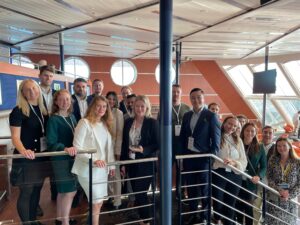
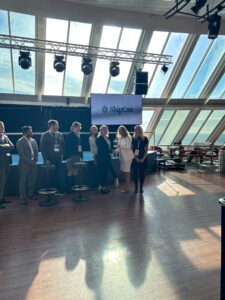
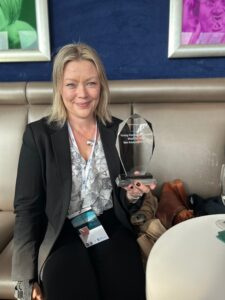
ShipCon 2023
The international ShipCon conference hosted by YoungShip Helsinki will be taking place on 21st - 22ndSeptember 2023.
YoungShip Helsinki welcomes all young and young minded maritime professionals to ShipCon 2023 in Helsinki in September! The Finnish department of YoungShip is proud to host the yearly event and highlight the unique know-how of the Finnish maritime cluster with the theme “Power of People – the Finnish Flavour”.
This year, focus will be on the future-proofing the maritime sector in terms of environmental impact, leadership, design and technology. The Finnish maritime cluster is a forerunner in sustainability, developing new technologies and green innovations.
How can we utilize Nordic knowledge to reduce emissions worldwide? How do we foster digital solutions and AI in making shipping smarter and more energy efficient? How do we encourage young people to choose a career in the maritime field and secure knowledgeable workforce in the future? These are just some of the topics that will be discussed during ShipCon 2023. Come and join the conversation!
“We are so excited to host ShipCon in Helsinki and highlight the Finnish maritime cluster and Baltic Sea region. With these current topics, we are hoping to gather maritime professionals from both Finland and our international network around the world. We want to encourage dialogue internationally and between generations. We have great speakers from the industry lined up and we’ll be announcing more about the program shortly.” says Hanna Donning, chair of YoungShip Helsinki.
The main part of the conference will take place in Central Library Oodi, in the heart of central Helsinki. The afternoon and evening program on Thursday will take place onboard m/s Finlandia. The conference will be in English and is open to everyone, not limited to YoungShip members. Tickets are available now. Please find more details on our website: https://www.youngship.com/shipcon/.
For more information and enquiries, please contact:
Hanna Donning
Chair YoungShip Helsinki
+35850 3359293
shipcon@youngship.com
YoungShip Helsinki is a non-profit organisation founded under the auspices of the renowned YoungShip International and created for the benefit and support of the younger members of the maritime and shipping industry.
Breakfast Seminar with American Bureau of Shipping, 1 June
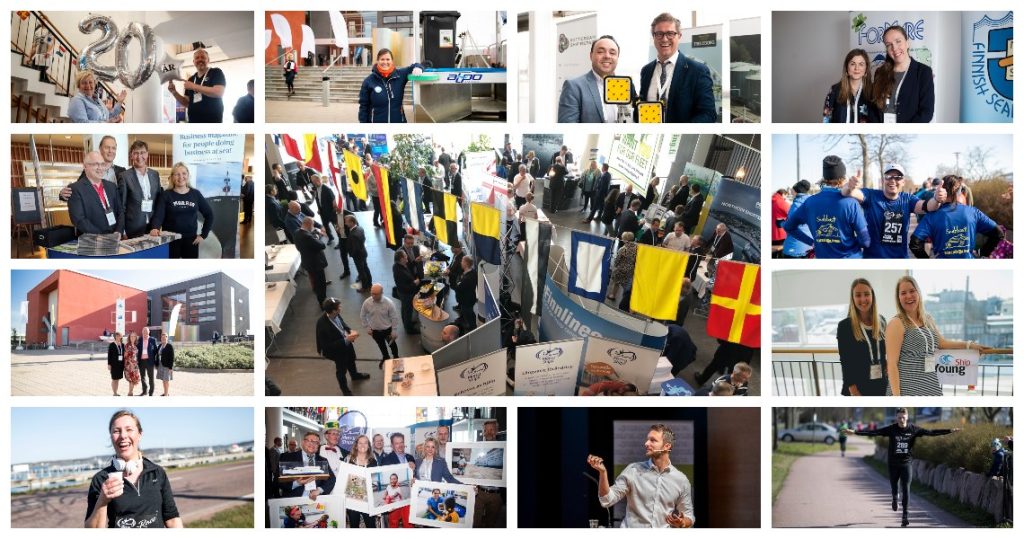
We are excited to share that the well received breakfast seminar typically held at the office premises of Sealines will be back in 1st of June before Åland Maritime Day as well as available online with Teams.
Program:
07:30 Event starts with network and breakfast
08:00 Seminar with American Bereau of Shipping - Daniele Bottino
ABS is one of the major classification societies in Europe, with a strong position in amongst other Denmark and other European countries such as Greece. As a leading global provider of classification and technical advisory services to the marine and offshore industries, they are committed to setting standards for safety and excellence in design and construction. Focused on safe and practical application of advanced technologies and digital solutions, ABS works with clients to develop accurate and cost-effective compliance, optimized performance and operational efficiency for marine and offshore assets.
With the changing environmental regulation landscape they are are working closely with their customer to promote energy-efficient practices and to ensure compliance with regulations related to safety, EEXI, CII, ETS. ABS is also supporting customers in the adoption of new fuels and technologies. Where one example of such support, is their status as a founding member of the Maersk McKinney Moller Center for Zero Carbon Shipping.
As a founding partner they bring a common commitment to decarbonizing shipping as well as providing unique and highly specialized knowledge and research capabilities.
Learn more on the ABS story from Daniele Bottino, Business Development Manager for Northern Europe covering Sweden, Finland and the Baltic States. He is based in Copenhagen where he is responsible for client relationship management and business development in the region. Daniele also serves as the Yacht Sector lead for ABS in Europe, working closely with owners, designers, builders and regulators in this specialized industry to advise on the latest developments in safety, reliability, structural and mechanical integrity and sustainable technologies
08:45 End of event
Time to move to Alandica for Åland Maritime Day. YoungShip Helsinki is having a stand at Alandica and we invite members and potential members to visit us there.
Many thanks to Sea Lines for sponsoring the breakfast and to Daniele Bottiono for taking the time!
The event is free of charge but we have limited places. Please indicate if you plan to attend onsite or via Teams when register.
